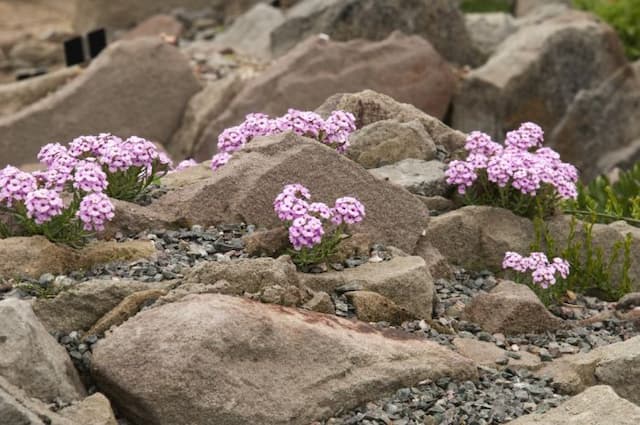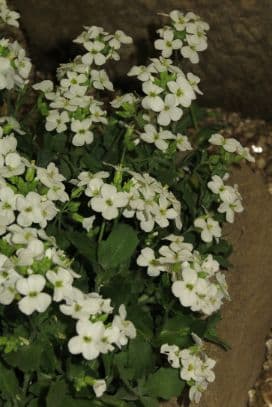False Rockcress Aubrieta 'Elsa Lancaster'

ABOUT
The Aubrieta 'Elsa Lancaster', commonly known as rock cress, is a vibrant and attractive plant renowned for its striking floral display. This perennial plant is characterized by its lush mat of small, oval-shaped, green leaves that form a dense, ground-hugging foliage. The leaves are slightly hairy, giving them a soft and fuzzy texture. The most captivating aspect of the Elsa Lancaster rock cress is its abundance of flowers. During its blooming season, the plant becomes smothered with large, four-petaled blossoms that create a vivid carpet of color. The flowers are a rich, deep purple hue that can appear almost iridescent in sunlight, with small, delicate yellow centers that add a striking contrast. This stunning display of blossoms not only adds a splash of color to gardens but also attracts a variety of pollinators, such as bees and butterflies, enhancing the biodiversity of the area. Overall, the Elsa Lancaster's combination of dense greenery and showy purple flowers make it an exceptional choice for gardeners looking to add a touch of color to rockeries, borders, or as a vibrant ground cover.
About this plant
 Names
NamesFamily
Brassicaceae
Synonyms
False Rockcress, Rock Cress, Rainbow Rock Cress
Common names
Aubrieta 'Elsa Lancaster'.
 Toxicity
ToxicityTo humans
Aubrieta, commonly known as rock cress, is not listed as a poisonous plant to humans. However, ingestion of any plant material can potentially cause a reaction due to individual sensitivities, so it is generally advised to not eat plants that are not specifically grown for food.
To pets
Rock cress is not typically listed as toxic to pets. However, just like with humans, pets may have individual reactions to ingesting plant material that is not intended for consumption. If a pet consumes rock cress and exhibits any unusual symptoms, it is advisable to consult a veterinarian.
 Characteristics
CharacteristicsLife cycle
Perennials
Foliage type
Evergreen
Color of leaves
Green
Flower color
Purple
Height
4 inches (10 cm)
Spread
24 inches (61 cm)
Plant type
Herb
Hardiness zones
4
Native area
Mediterranean
Benefits
 General Benefits
General Benefits- Low maintenance: Once established, Aubrieta 'Elsa Lancaster' requires minimal care and can thrive with basic watering and occasional feeding.
- Drought tolerance: This plant is well-adapted to survive in dry conditions, making it ideal for water-wise gardens.
- Ground cover: With its spreading habit, it provides excellent ground cover, reducing weed growth and soil erosion.
- Spring blooms: Produces vibrant purple flowers in spring, adding color and beauty to garden spaces.
- Attracts pollinators: The flowers attract bees and butterflies, which are beneficial for pollination of gardens and ecosystems.
- Rock gardens: Its ability to grow in rocky or gravelly soils makes it a perfect choice for rock gardens or alpine settings.
- Border planting: Can be used to create attractive borders along pathways or garden beds.
- Container gardening: Suitable for cultivation in containers, allowing for gardeners with limited space to enjoy its beauty.
 Medical Properties
Medical PropertiesThis plant is not used for medical purposes.
 Air-purifying Qualities
Air-purifying QualitiesThis plant is not specifically known for air purifying qualities.
 Other Uses
Other Uses- Aubrieta 'Elsa Lancaster', commonly known as rock cress, can be used in a miniature garden or a fairy garden setup to add a pop of color and simulate a lush, mystical landscape.
- Rock cress can serve as a natural dye for fabrics, providing a range of colors from greens to yellows depending on the mordant used.
- Dried flowers of rock cress can be incorporated into potpourri mixes for their subtle color and durability.
- It can be used to create living mulch in a garden bed, helping to maintain soil moisture and suppress weeds.
- Rock cress leaves can be used in floral arrangements to add greenery and complement the more prominent flowers on display.
- When pressed or dried, the flowers of rock cress may be used in crafting beautiful bookmarks, greeting cards, or pressed flower art.
- It can be used as an educational tool in schools to teach students about plant growth, ground cover species, and pollinator attractions.
- Rock cress can be used in green roofing projects to provide an attractive, low-maintenance vegetative layer.
- For photography enthusiasts, rock cress offers a vibrant subject for macro photography and nature-inspired compositions.
- The plant can be used as a ground cover around the base of ornamental trees for visual consistency and soil stabilization.
Interesting Facts
 Feng Shui
Feng ShuiThe Aubrieta is not used in Feng Shui practice.
 Zodiac Sign Compitability
Zodiac Sign CompitabilityThe Aubrieta is not used in astrology practice.
 Plant Symbolism
Plant Symbolism- Perseverance - Aubrieta, commonly known as False Rockcress, often grows in rocky, challenging conditions, symbolizing the ability to thrive despite adversity.
- Beauty in Simplicity - With its modest yet colorful blooms, False Rockcress represents finding joy in the simple things.
- New Beginnings - As a spring bloomer, False Rockcress signifies starting anew and embracing fresh starts.
- Survival - Its drought resistance and ability to grow in poor soils signify endurance and the strength to survive in harsh environments.
 Water
WaterFalse rockcress (Aubrieta) should be watered deeply but infrequently to mimic its native habitat conditions. Typically, watering once a week with approximately two gallons of water is sufficient, but this may vary depending on climate and soil conditions. During hot and dry periods, increase watering to every few days, ensuring the soil is allowed to dry out between waterings. Overwatering can lead to root rot, so it's important to ensure good drainage. Reduce watering in the winter months when the plant is dormant.
 Light
LightFalse rockcress thrives in full sun but can tolerate partial shade. The best spot for the plant is one where it can receive at least six hours of direct sunlight daily. If you are growing false rockcress in a region with scorching summer sun, it can benefit from light afternoon shade to protect it from the most intense rays.
 Temperature
TemperatureFalse rockcress prefers cooler temperatures and does well in regions with mild summers and cold winters. The plant can survive minimum temperatures down to about -20 degrees Fahrenheit, but the ideal range is between 60 to 75 degrees Fahrenheit. Protect the plant from extreme cold and ensure that it has enough coverage to survive winter conditions.
 Pruning
PruningPrune false rockcress to promote bushy growth and to refresh the plant after it has finished blooming. The best time to prune is immediately after the flowering period, usually in late spring or early summer. Cut back the spent flower stems and trim about a third of the plant's overall growth to maintain its shape and encourage new blooms for the following season. Annual pruning helps to prevent the center from dying out and keeps the plant looking its best.
 Cleaning
CleaningAs needed
 Soil
SoilRock cress, including Aubrieta 'Elsa Lancaster', thrives best in well-draining, gritty, alkaline soil with a pH around 6.5 to 7.5. A mix comprising one-third topsoil, one-third compost, and one-third coarse sand or perlite would provide ideal conditions for growth and flowering.
 Repotting
RepottingRock cress rarely needs to be repotted as it is a low-growing perennial commonly used in rock gardens. If grown in containers, repotting every 2 to 3 years should be sufficient to replenish the soil and provide space for growth.
 Humidity & Misting
Humidity & MistingRock cress is quite tolerant of different humidity levels but prefers drier conditions. It does not require high humidity and will flourish in typical outdoor humidity levels without any special care.
 Suitable locations
Suitable locationsIndoor
Place in bright light, ensure good air circulation.
Outdoor
Full sun, well-drained soil, tolerate drought.
Hardiness zone
4-9 USDA
 Life cycle
Life cycleThe Aubrieta 'Elsa Lancaster', also known as Purple Rock Cress, begins its life cycle when seeds are sown, typically in late spring or early summer. After germination, the seedlings develop into a low, mat-forming perennial that produces small, oval-shaped, green leaves. Foliage grows denser as the plants mature through the summer and fall. In early to mid-spring of the following year, Aubrieta 'Elsa Lancaster' bursts into bloom with a profusion of small, purple flowers, which attract pollinators and adorn the garden with vibrant color. After flowering, the plant sets seeds which can be collected if desired or left to self-sow, creating new plants nearby. As a hardy perennial, Purple Rock Cress will die back in late fall, lying dormant through the winter months to start the cycle anew the following spring.
 Propogation
PropogationPropogation time
Spring-Early Summer
The most popular method of propagating Aubrieta 'Elsa Lancaster', commonly known as Rock Cress, is by stem cuttings. To propagate Rock Cress using this method, a gardener would typically take cuttings in late spring or early summer when the plant is actively growing. The cuttings should be about 3 to 4 inches long and include several leaves. It's advisable to remove the lower leaves and dip the cut end in a rooting hormone to encourage growth. The stem cuts are then planted in a well-draining soil mixture and kept moist until roots develop, which usually takes a few weeks. Providing a consistent temperature of around 70 degrees Fahrenheit (21 degrees Celsius) can enhance the rooting process. Care should be taken to avoid direct sunlight on the new cuttings to prevent scorching while they establish roots.



![Aubrieta [Axcent Light Blue]](/_next/image?url=https%3A%2F%2Fplants-admin.emdemapps.com%2Fimages%2Fplants%2F%2Fimages%2F604b5e7128866.png&w=640&q=75)





